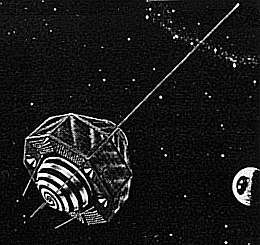Explorer 29
 Image of Explorer 29. | |
| Mission type | Earth science |
|---|---|
| Operator | NASA |
| COSPAR ID | 1965-089A[1] |
| SATCAT no. | 1726 |
| Spacecraft properties | |
| Manufacturer | Applied Physics Laboratory[2] |
| Launch mass | 387 kg (853 lb) |
| Start of mission | |
| Launch date | 6 June 1965, 18:38:43 UTC[3] |
| Rocket | Delta-E |
| Launch site | Cape Canaveral LC-17B |
| Orbital parameters | |
| Reference system | Geocentric |
| Regime | Low Earth |
| Eccentricity | 0.07193[1] |
| Perigee | 1,113 kilometers (692 mi)[1] |
| Apogee | 2,275 kilometers (1,414 mi)[1] |
| Inclination | 59.4 degrees[1] |
| Period | 120.3 minutes[1] |
| Epoch | 6 June 1965[1] |
Explorer 29 (also called GEOS 1 or GEOS A, acronym to Geodetic Earth Orbiting Satellite) was an American satellite launched as part of the Explorers program, being the first of the two satellites GEOS. Explorer 29 was launched on 6 November 1965 from Cape Canaveral, Florida, United States, with Delta rocket.
Explorer 29 was a gravity-gradient-stabilized, solar cell powered unit designed exclusively for geodetic studies. It was the first successful active spacecraft of the National Geodetic Satellite Program. Instrumentation included:
- Optical Beacon System
- Laser Tracking Reflector
- Radio Doppler System
- SECOR Range Transponder
- Radio Range/Rate System
These were designed to operate simultaneously to fulfill the objectives of locating observation points (geodetic control stations) in a 3 dimensional earth center-of-mass coordinate system within 10 metres (33 ft) of accuracy, of defining the structure of the earth's irregular gravitational field and refining the locations and magnitudes of the large gravity anomalies, and of comparing results of the various systems onboard the spacecraft to determine the most accurate and reliable system. Acquisition and recording of data were the responsibility of the GSFC Space Tracking and Data Acquisitions Network (STADAN). Ten major observing networks were used.[1]
References
- 1 2 3 4 5 6 7 8 "GEOS 1". NSSDCA. NASA Goddard Space Flight Center. Retrieved 10 June 2018.

- ↑ "GEOS". Encyclopedia Astronautica. Mark Wade. Retrieved 10 June 2018.
- ↑ McDowell, Jonathan. "Launch Log". Jonathan's Space Page. Retrieved 10 June 2018.
External links
.png)